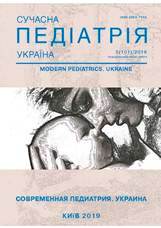Assessing the psychomotor development using the denver screening test II in infants who have had jaundice in the neonatal period
Abstract
Material and methods. 86 children who have had jaundice in the neonatal period were examined and were divided into 2 groups depending on gestational age at the time of birth: Group I — full term (n=54), Group II — born prematurely (n=32). All examined at 3, 6, 9, 12 months were assessed for psychomotor development using the Denver screening test II. To study the influence the neonatal hyperbilirubinemia on hematoencephalic barrier (blood0brain barrier) permeability in all children in the dynamics of the neonatal period (1–3, 5–7, 21–28 days), neurospecific proteins — neurospecific enolase (NSE), glial fibrillary acidic protein (GFAP) and trophic brain factor (BDNF) were identified.Results and conclusions. The results of the study showed that 22.2% of full0term and 35.3% of prematurely born children who had hyperbilirubinemia in the neonatal period had a delay in development. In children with psychomotor retardation, both full0term and prematurely born, higher levels of neurospecific proteins were observed in the neonatal period compared with children with normal psychomotor development, which allows using these indicators as prediction criteria.
The research was carried out in accordance with the principles of the Helsinki Declaration. The study protocol was approved by the Local Ethics Committee (LEC) of an institution.
References
Vedunova МV, Sakharnova ТА, Mitroshina EV, Mukhina IV. (2012). Antihypoxic Properties of the Brain-Derived Neurotrophic Factor in the Modeling of Hypoxia in Dissociated Hippocampal Cultures. Modern Technologies in Medicine. 4: 17–23.
Demyanova IM, Taranushenko TE, Salmina AB i dr. (2008). Markeryi povrezhdeniya neyronov i astrotsitov v plazme krovi novorozhdennyih pri tserebralnoy ishemii raznoy stepeni tyazhesti. Sibirskoe meditsinskoe obozrenie. 2: 27–31.
Rogatkin SO, Volodin NN, Degtyareva MG i dr. (2011). Sovremennyiy podhod k tserebroprotektornoy terapii nedonoshennyih novorozhdennyih v usloviyah otdeleniya reanimatsii intensivnoy terapii. Zhurnal nevrologii i psihiatrii. 1: 27–32.
Taranushenko TE, Okuneva OS, Demyanova IM i dr. (2010). Urovni belkov neyronalnoy i glialnoy prirodyi v krovi novorozhdennyih pri tserebralnoy ishemii. Pediatriya. 89;1: 25–31.
American Academy of Pediatrics, Clinical Practice Guideline, Subcommittee on Hyperbilirubinemia (2004). Management of the newborn 35 or more weeks of gestation. Pediatrics. 114: 297–316. https://doi.org/10.1542/peds.114.1.297; PMid:15231951
Amin SB, Harte T, Scholer L, Wang H. (2009). Intravenous lipid and bilirubin-albumin binding variables in premature infants. Pediatrics. 124: 211–217. https://doi.org/10.1542/peds.2008-0846; PMid:19564302 PMCid:PMC4285415
Aylward GP. (2009). Developmental screening and assessment: what are we thinking? J Dev Behav Pediatr. 30(2): 169–173. https://doi.org/10.1097/DBP.0b013e31819f1c3e; PMid:19363370
Glasco FP. (2008). Developmental screening & surveillance. In: RM Kliegman, RE Behrman, HB Jenson, BM Stanton (Eds.). Nelson Textbook of Pediatrics. (18th ed.). Philadelphia: Saunders: 74–81.
Hacettepe Universitesi Nufus Etutleri Enstitusu, Saglik Bakanligi Ana Cocuk Sagligi ve Aile Planlamasi Genel Mudurlugu, Devlet Planlama Teskilati ve Avrupa Birligi. (2008). Hacettepe Universitesi Etutleri Enstitusu, Turkiye Nufus ve Saglik Arastirmasi. Ankara/Hacettepe Universitesi Nufus Etutleri Enstitusu: 2009.
Hansen TWH, Bratlid D. (2012). Physiology of neonatal unconjugated hyperbilirubinemia. In: DK Stevenson, MJ Maisels, JF Watchko (Eds.). Care of Jaundiced Neonate. New York: McGraw-Hill: 65–95.
Madinier A, Bertrand N, Rodier M, Quirie A, Mossiat C, Prigent-Tessier A et al. (2013). Ipsilateral versus contralateral spontaneous post-stroke neuroplastic changes: involvement of BDNF? Neuroscience. 231: 169–81. https://doi.org/10.1016/j.neuroscience.2012.11.054; PMid:23219910
Maisels MJ, Bhutani VK, Bogen D Newman TB, Stark AR, Watchko JF. (2009). Hyperbilirubinemia in the newborn infant >35 weeks gestation: an update with clarication. Pediatrics. 124: 1193–1198. https://doi.org/10.1542/peds.2009-0329; PMid:19786452
Nguyen DN, Spapen H, Fuhong S et al. (2009). Elevated serum levels of S-100b protein and neuron-specific enolase are associated with brain injury in patients with severe sepsis and septic shock. Crit Care Med. 34: 7. https://doi.org/10.1097/01.CCM.0000217218.51381.49; PMid:16607230
Schwarz HP, Haberman BE, Ruddy RM. (2011). Hyperbilirubinemia. Current guidelines and emerging therapies. Pediatr Emer Care. 27: 884–889. https://doi.org/10.1097/PEC.0b013e31822c9b4c; PMid:21926893
Shapiro SM. (2012). Kernicterus. In: DK Stevenson, MJ Maisels, JF Watchko (Eds.). Care of Jaundiced Neonate. New York: McGraw-Hill: 229–242.
Slusher TM, Olusaniya BO. (2012). Neonatal jaundice in low- and middle-income countries. DK Stevenson, MJ Maisels, JF Watchko (Eds.). Care of Jaundiced Neonate. New York: McGraw–Hill: 263–273.
Tiker F, Gulcan H, Kilicdag H, Tarcan A, Gurakan B. (2006). Extreme hyperbilirubinemia in newborn infants. Clin Pediatr (Phila).45: 257–261. https://doi.org/10.1177/000992280604500308; PMid:16708139
Watchko JF, Tribelli C. (2013). Bilirubin-induced neurologic damage-mechanisms and Management approaches. N Engl J Med. 369: 2021–2030. https://doi.org/10.1056/NEJMra1308124; PMid:24256380
Downloads
Issue
Section
License
The policy of the Journal “MODERN PEDIATRICS. UKRAINE” is compatible with the vast majority of funders' of open access and self-archiving policies. The journal provides immediate open access route being convinced that everyone – not only scientists - can benefit from research results, and publishes articles exclusively under open access distribution, with a Creative Commons Attribution-Noncommercial 4.0 international license (СС BY-NC).
Authors transfer the copyright to the Journal “MODERN PEDIATRICS. UKRAINE” when the manuscript is accepted for publication. Authors declare that this manuscript has not been published nor is under simultaneous consideration for publication elsewhere. After publication, the articles become freely available on-line to the public.
Readers have the right to use, distribute, and reproduce articles in any medium, provided the articles and the journal are properly cited.
The use of published materials for commercial purposes is strongly prohibited.

